Flags of Europe
Appearance
This is a list of international, national and subnational flags used in Europe.
International flags
| Flag | Date | Use | Description |
|---|---|---|---|
 |
1955 – | The Flag of Europe. Originally adopted in 1955 by the Council of Europe as a symbol of European unity. Later adopted by the European Parliament (1983) and European Communities (1986) which became the European Union in 1992. | A circle of 12 upward-oriented 5-pointed golden stars centered on a blue field. |
 |
1991 – | Flag of the Commonwealth of Independent States | The flag of the Commonwealth of Independent States is blue with the emblem of the organization in the centre. |
| File:Flag of the Commonwealth of Nations.svg | 1991 – | Flag of the Commonwealth of Nations | The flag of the Commonwealth of Nations consists of the Commonwealth symbol in gold on a blue background. |
 |
1984 – | Flag of the Nordic Council | White stylised swan, with eight feathers, on a blue disk upon a white background. |
| 1953[1] – | Flag of the North Atlantic Treaty Organisation | A navy blue field charged with a white compass rose emblem from which radiate four white lines. | |
 |
1993 – | Flag of the Western European Union | Similar to the European: A semicircle of 10 5-pointed gold stars on a blue field with white initials WEU and UEO in the centre. |
 |
1958/1986 – 2002 | Flag of the European Coal and Steel Community | Two horizontal bars, blue on top and black below, with white stars in two rows along the middle. Number of stars depends on states but fixed at 12 from 1985. |
| File:Flag of OIC.svg | 1969 – | Organisation of the Islamic Conference | Has an overall green background, this is to represent the green fertilty of the Islamic lands (This is also said to be symbolic to Islam). In the center, there is an upward-facing red crescent enveloped in a white disc which is to symbolise Islam and that Allah is higher than all of the human beings. The white disc represents Peace amongst the Muslims and all humans living in the world. On the disc the words "Allahu Akbar" are written in what appears to be modern Arabic calligraphy. |
Flags of European Union nations
Flags of European Union members
| Flag | Date | Use | Description |
|---|---|---|---|
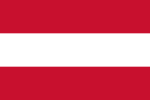 |
1230- | Flag of Austria, originally adopted in 1918, was officially adopted (again) in 1945, after being banned during World War II. | Stripes of red and white have been a collective emblem of Austria for over 800 years, and their first usage on the flag occurred in 1191. According to long established legend, the red and white flag was designed to resemble the bloodstained white coat worn by the Duke of Austria during a fierce battle. |
 |
1831- | The flag of Belgium was officially adopted on January 23, 1831. | Black, gold and red are symbolic of the country's coat of arms; black representing the shield; gold representing the lion, and red representing the lion's claws and tongue. The vertical layout is taken from the French Tricolore. |
 |
1878- | Flag of Bulgaria | The flag of Bulgaria was adopted in 1989 and consists of three horizontal bands of white, green and red. Originally the central band was blue, however after Bulgarian independence in 1878, the central band was replaced with green. |
 |
1960- | The flag of Cyprus was officially adopted on August 16, 1960. | The island is depicted in a copper shade representative of its name, Cyprus: the Greek word for copper. The crossed green olive branches symbolize the hope for peace between the Turks and the Greeks. It was designed by İsmet Güney, a Turkish Cypriot painter. |
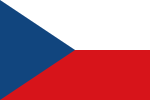 |
1920- | Flag of the Czech Republic | The first flag of Czechoslovakia was white over red, and those colors are the heraldic colors of Bohemia. The blue triangle was added to the flag in an effort to distinguish it from the Polish flag, and blue is said to represent the State of Moravia. |
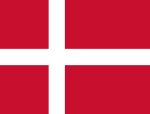 |
1219- | The flag of Denmark its flag is Europe's oldest state flag still in use. Legend has it that it appeared as a sign from heaven to King Valdemar II in 1219. | Known as the Dannebrog ("Danish Cloth"), this blood-red flag with an off-centered white cross (a "Scandinavian Cross") became a model for other regional flags. |
 |
1918-1940 1990- |
The flag of Estonia officially re-adopted on May 8, 1990. | Blue represents loyalty, and the country's beautiful blue skies, seas and lakes; black is symbolic of past oppression and the fertile soil; and white represents virtue, winter snows, and Estonia's long struggle for freedom and independence. |
 |
1918- | The flag of Finland was officially adopted on May 29, 1918. | The off-centered blue cross is based on the Scandinavian Cross, widely used on Scandinavian national flags. The blue color is symbolic of blue skies, and the thousands of lakes in Finland. The white represents the winter snows. |
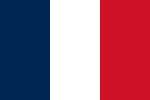 |
1794-1815 1830- |
The flag of France was officially adopted on February 15, 1794. | The tricolore consists of three vertical bands of equal width, displaying the country's national colors: blue, white, and red. The blue band is positioned nearest the flag-staff, the white in the middle, and the red on the outside. Red, white and blue have come to represent liberty, equality and fraternity - the ideals of the French Revolution. Blue and red are also the time-honored colors of Paris, while white is the color of the Royal House of Bourbon. |
 |
1919-1933 1949- |
The flag of Germany was officially re-adopted on May 23, 1949 and subsequently used by West Germany while the country was divided into East and West before reunification in 1990. | The tricolor flag was designed in 1832, and the black, red, and gold colors were taken from the uniforms of German soldiers during the Napoleonic Wars or taken from the coat of arms of Holy Roman Empire. |
 |
1978 - | The flag of Greece was officially adopted in 1822. | Features a white cross, and a combination of nine blue and white horizontal stripes. The shade of blue has varied over the years, and darker blue (shown) is now commonly used. The cross is symbolic of the Greek religious faith and the nine stripes represent the nine syllables in the cry "Freedom or Death," one commonly used during the Greek War of Independence. The white is said to reflect the purity of that struggle. |
 |
1848- | The flag of Hungary: was officially adopted in 1848. | The overall design is modeled after the French Tricolore. Red is said to symbolize strength, green hope, and white faithfulness. |
 |
1922- | The flag of Ireland was officially adopted on January 21, 1919. | Modeled after the French Tricolore, Ireland's flag uses color to symbolize religions. Green is representative of Catholics, orange is representative of Protestants, and the white is symbolic of the union of both. |
 |
1948- | Flag of Italy | Derived from an original design by Napoleon, it consists of three vertical bands of equal width, displaying the national colors of Italy: green, white, and red. Green was said to be Napoleon's favorite color. |
 |
1918-1940 1990- |
The flag of Latvia was officially adopted on February 27, 1990. | The design is symbolic of a revered time-honored legend of a wounded Latvian leader: the deep red color represents the blood he shed, and the white the cloth used to wrap his wounds. |
 |
1918-1940 1989- |
The flag of Lithuania was officially re-adopted on March 20, 1989, before Lithuania gained independence from the Soviet Union in 1991. | Yellow is symbolic of the country's wheat fields, green symbolic of the forests, and red symbolizes patriotism. Collectively the colors represent hope for the future, freedom from oppression, and the courage of the Lithuanian people. |
 |
1972- | The flag of Luxembourg was officially adopted in 1972, although used since 1848 following Luxembourg's independence from the Netherlands in the late 1800s. | The flag uses a combination of red, white, and blue that date to the 13th century, and the Grand Duke's coat of arms. |
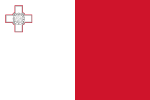 |
1964- | The flag of Malta was officially adopted on September 21, 1964. | The flag uses the traditional red and white colors which predate those of the Knights of Malta and which emulate the arms of the former Universitas of Mdina. The George Cross (upper left), outlined in red, was added to the flag in the 1940s, as King George VI of the United Kingdom presented it to islanders for outstanding gallantry during World War II. |
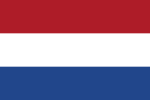 |
1937- | The flag of the Netherlands was officially adopted on February 19, 1937. | At one time this tricolor flag was orange, white, and blue, as those were the livery colors of William of Orange, a Dutch prince. In the 17th century, red replaced the orange as a flag color, because the orange dye used on the flag was unstable, and turned red after exposure to the sun. |
 |
1919- | The flag of Poland was officially adopted on August 1, 1919. | Red and white have long been associated with Poland and its coat of arms. |
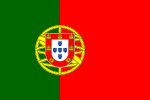 |
1911- | The flag of Portugal was officially adopted on June 30, 1911. | The design is symbolic of Portuguese voyages that would make the country the first to discover the ocean routes to India, Brazil, China, and Japan, and at the same time establish settlements on the east and west coasts of Africa. Green is representative of King Henry the Navigator, a famed Portuguese explorer. The centered shield is representative of ocean exploration and the expansion of Portugal's influence during the reign of King Afonso Henriques. Red recalls the internal revolution of the early 1800s. |
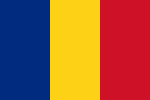 |
1867- | The flag of Romania was officially re-adopted in 1994 but has been in use since 1989. The first flag dates from 1834 but the colors themselves are thought to have had special significance even since the 6th century. The current layout dates since 1867 | A vertical tricolour of bands of blue, yellow, and red of equal width and overall proportions of 2:3 (height-width). It is inspired by the French flag. |
 |
1992- | The flag of Slovakia was officially adopted on September 1, 1992. | Red, white, and blue are traditional Pan-Slavic colors. The centered Slovakian arms features a dominant white cross atop a blue symbolic reference to the country's mountains. |
 |
1991- | The flag of Slovenia was officially adopted on June 24, 1991. | Red, white, and blue are taken from the Carniolan coat of arms. The flag without the coat of arms was in use from 1848 to 1945. The Slovenian coat of arms features three gold stars, symbolizing the Counts of Celje. The mountains shown in white are representative of the Alps, and Mount Triglav, Slovenia's national symbol, in particular; the wavy blue lines across the bottom indicate Slovenia's access to the sea. |
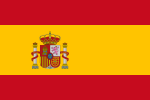 |
1981- | The flag of Spain was officially adopted on July 19, 1927, though use of similar designs dates to the late 18th century. | The red and golden-yellow colors were first used in the late 1700s by the King of Spain as he tried to easily differentiate his ships from those of other countries. They're also the original colors found within the arms of both the Castile, Aragon and Navarre regions of the country, the regions first united by King Ferdinand and Queen Isabella. |
 |
1569- | The flag of Sweden was officially adopted on June 22, 1906. | The off-centered yellow cross (The Scandinavian Cross) is taken from the Danish flag. The yellow and blue colors are taken from the national coat of arms. |
 |
1801- | The current flag of the United Kingdom dates from the Act of Union 1800, which merged the Kingdom of Great Britain and the Kingdom of Ireland to form His/Her Majesty's United Kingdom of Great Britain and Ireland. | Consists of the red cross of Saint George (patron saint of England), edged in white, superimposed on the diagonal red cross of Saint Patrick (patron saint of Ireland), which are superimposed on the saltire of Saint Andrew (patron saint of Scotland). |
Flags of European Union candidates
| Flag | Date | Use | Description |
|---|---|---|---|
 |
1990 – | Flag of Croatia | The flag of Croatia, adopted in December 1990, consists of three equal horizontal stripes of red, white and blue, which has been the Croatian flag since 1848. In the middle is the Coat of arms of Croatia, which replaced a five-pointed red star with yellow border in the centre, which was there when Croatia was part of Yugoslavia. |
 |
1995 – | Flag of the Republic of Macedonia | The flag of the Republic of Macedonia depicts a rising yellow sun with eight rays extending to the edges of the red field. It represents "the new sun of liberty", evoked in the Macedonian national anthem Denes nad Makedonija (Today Over Macedonia). |
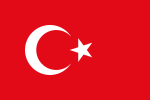 |
1844 as Ottoman Turkey flag and 1923 as flag of the Republic of Turkey | Flag of Turkey | The flag of Turkey consists of a white crescent moon and a star on a red background. The flag is practically identical to the last flag of the Ottoman Empire, adopted in 1844. There are several claims as to the origin of that flag. |
Dependencies and autonomous regions of European Union members in Europe
| Flag | Date | Use | Description |
|---|---|---|---|
 |
1954- | The flag of Åland (Finland) was officially adopted 3 April 1954. As of 1992, it serves as the civil and state flag and ensign. | This traditional Scandinavian Cross flag features blue, yellow, and red, all said to be borrowed from the national colours of Sweden and Finland. |
 |
1918- | Flag of Andalusia | The flag of Andalusia consists of a horizontal tricolour (green-white-green) with the Andalusian arms in the centre. |
 |
1960- | Flag of Akrotiri and Dhekelia | The current flag of both Akrotiri and Dhekelia] Sovereign Base Areas (SBAs) is the Union flag as no flag exists for the SBAs. |
| File:Flag of the Aosta Valley.png | 1947- | Flag of the Aosta Valley | The flag of the Aosta Valley consists of two vertical stripes (the left black the right red) with the arms of the Aosta Valley in the centre. |
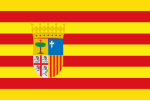 |
1982- | Flag of Aragon | |
 |
1982- | Flag of Asturias | The flag of Asturias is light blue with the Victory Cross slightly left of the centre. |
 |
1983- | Flag of the Balearic Islands | |
 |
1978- | Flag of the Basque Country | |
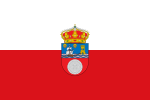 |
1984- | Flag of Cantabria | |
 |
1982- | Flag of Castile-La Mancha | |
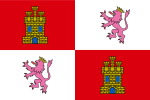 |
1983- | Flag of Castile and León | |
 |
1082- | Flag of Catalonia | The flag of Catalonia consists of a gold color on this and the four bars in red. That according to legend King II Carles painted with fingers stained with the blood of the Conde de Barcelona. |
 |
1983- | Flag of Extremadura | |
 |
1940- | Merkið, the flag of the Faroe Islands (Denmark) was first used in 1919, was mandated by the British as the civil and state ensign in 1940, and became the official civil and state flag and ensign on 23 March 1948. | The flag uses Norwegian colors, commemorating the Faroes once being part of Norway. |
 |
2001- | Flag of Friuli-Venezia Giulia | |
 |
1984- | Flag of Galicia | |
 |
1502- | Flag of Gibraltar | The Gibraltar flag dates from 1502, as it's based on the original arms granted it by Spain. The red and white field is taken from the arms, and it's dominated by a red three-towered fortress, complete with a gold key. |
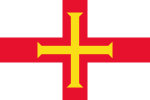 |
1985- | Flag of Guernsey | The flag of Guernsey, adopted in 1985, consists of the red cross of St. George with an additional gold cross within it. The change was prompted by confusion over Guernsey and England using the same flag. The gold cross represents Duke William of Normandy, who had such a cross on his flag in the Battle of Hastings, given to him by Pope Alexander II. |
 |
c13- | Flag of the Isle of Man | The flag of the Isle of Man features a red field with a centered triskelion of three bent legs joined at a central point. |
 |
1980- | Flag of Jersey | The flag of Jersey, adopted in June 1979, is white with a diagonal red cross, surmounted by a yellow Plantagenet crown, the badge of Jersey (a red shield holding the three leopards of Normandy in yellow). Prior to this, the flag was a plain red saltire on a white field. |
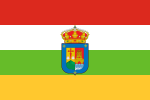 |
1982- | Flag of La Rioja | |
 |
1983- | Flag of Madrid | |
| File:Flag of the Byzantine Empire.svg | Flag of Mount Athos | The flag of Mount Athos shows the state arms on a yellow field. | |
 |
1982- | Flag of the Region of Murcia | |
 |
1982- | Flag of Navarre | |
 |
1999- | Flag of Sardinia | |
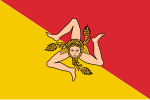 |
2000- | Flag of Sicily | |
 |
1983- | Flag of Trentino-Alto Adige/Südtirol | |
 |
1982- | Flag of Valencia |
see also Gallery of flags based on British ensigns
Flags of European nations in the Commonwealth of Independent States
| Flag | Date | Use | Description |
|---|---|---|---|
 |
1918-1920; 1990– | Flag of Armenia | The flag of Armenia (or the "Armenian Tricolor") was officially adopted on August 24, 1990. It was first used by the short-lived Democratic Republic of Armenia from 1918-1920. According to the Constitution of Armenia, "red symbolizes the Armenian Highland, the Armenian people's continued struggle for survival, maintenance of the Christian faith, Armenia's independence and freedom. Blue symbolizes the will of the people of Armenia to live beneath peaceful skies. Orange symbolizes the creative talent and hard-working nature of the people of Armenia."[1] |
 |
1991– | Flag of Azerbaijan | The flag of Azerbaijan was officially adopted on February 5, 1991. It is based on an earlier flag used by the short-lived Azerbaijan Democratic Republic (1918-1920). It features three equal horizontal bands of blue, red, and green. A crescent and eight-pointed star, Turkish symbols, are centered in the red band which represents progress. The country had a long alliance with Turkey, and the blue color has long been associated with the Turkic peoples. Green symbolizes Islam. |
 |
1995– | Flag of Belarus | Belarus' flag was officially adopted on May 16, 1995. The dominant red and green were colors used on its flag when it was a republic of the former Soviet Union. The woven fabric ornament on the left uses traditional Belarusian red and white colors. |
 |
2004– | Flag of Georgia | This recently adopted flag is a simple white rectangle, with a central red cross connecting all four sides of the flag; in each of the four corners is a small red Bolnur-Katskhuri Cross. The flag is based on a historic five-cross design that dates back to the 14th century. |
 |
1992– | Flag of Kazakhstan | The flag was officially adopted on June 4, 1992 after Kazakhstan seceded from the former Soviet Union. The blue field is said to symbolize the sky above the people. A golden steppe eagle is represented beneath the shining sun, and a traditional national ornamentation is shown at left. |
 |
1990– | Flag of Moldova | Moldova's flag was officially adopted on May 12, 1990. Once part of Romania, Moldova's flag reflects that association, as the two countries use almost identical shades of red, yellow and blue in their national flags. The centered Moldova shield's main feature is a golden eagle holding an Orthodox Christian Cross in its beak. The olive branch is said to symbolize peace. |
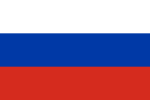 |
1896-1917; 1991– | Flag of the Russian Federation | The Russian Federation flag was officially adopted on August 22, 1991. The flag was hoisted shortly after the former Soviet Union collapsed. The white, red and blue are both Pan-Slavic colors, and the original colors of the Netherlands's flag. |
 |
1917-1919; 1991– | Flag of Ukraine | Ukraine's flag was adopted on September 4, 1991, shortly after the collapse of the former Soviet Union. This is the country's original flag used by the short-lived Ukrainian People's Republic, but it was banned for many decades under German and Soviet occupations. The shade of blue is said to be symbolic of the sky, while the yellow represents Ukraine's golden wheat fields. |
Flags of other European nations
| Flag | Date | Use | Description |
|---|---|---|---|
 |
1992 – | Flag of Albania | The flag of Albania, adopted in April 1992, is a red flag with a black two-headed eagle in the centre. It is derived from the seal of Gjergj Kastriot Skanderbeg, a 15th century Albanian who led the revolt against the Ottoman Empire that resulted in brief independence for Albania from 1443 to 1478. |
 |
1866 – | Flag of Andorra | The flag of Andorra, adopted in 1866, is a tricolor of blue, yellow, and red with the coat of arms of Andorra in the center. It is based on the flags of France and Spain. |
 |
1998 – | Flag of Bosnia and Herzegovina | The flag of Bosnia and Herzegovina consists of a wide medium blue vertical band on the fly side with a yellow isosceles triangle abutting the band and the top of the flag. The remainder of the flag is medium blue with seven five-pointed white stars and two half stars top and bottom along the hypotenuse of the triangle. The three points of the triangle stand for the three nations of Bosnia: Bosniaks, Croats, and Serbs. It is said to represent the map of Bosnia. |
 |
1915 – | Flag of Iceland | The flag of Iceland was adopted in June 1915 to represent Iceland. In June 1944 it was instated as the flag of the independent republic of Iceland. Like other Scandinavian flags, it is based on the Scandinavian Cross. It is a reverse color image of the Flag of Norway. The blue represents the sea, the white represents the snow and glaciers and the red symbolizes volcanic lava. |
 |
1937 – | Flag of Liechtenstein | The flag of Liechtenstein consists of two horizontal bands of blue and red with a gold crown. |
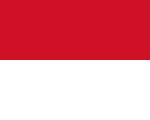 |
1881 – | Flag of Monaco | The flag of Monaco has two horizontal bands of red and white - these have been the heraldic colors of the House of Grimaldi since 1339 at least. |
 |
2004 – | Flag of Montenegro | The flag of Montenegro, adopted in July 2004, is a red banner bearing the coat of arms adopted in 1993. The coat of arms derives from those of King Nikola. |
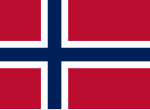 |
1821 – 1844, 1898 – | Flag of Norway | The flag of Norway is red with a blue Scandinavian cross outlined in white; the vertical part of the cross is shifted to the hoist side in the style of the Dannebrog, the flag of Denmark. It was adopted in 1821, but a union mark was added in the canton from 1844 to 1898. |
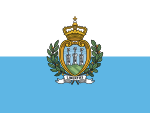 |
Flag of San Marino | The flag of San Marino comprises equal horizontal bands of white and light blue with the national coat of arms superimposed in the center. | |
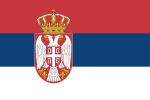 |
1882 – 1918, 2004 – | Flag of Serbia | The flag of Serbia consists of three horizontal bands of red, blue and white, with the coat-of-arms located left of centre. By accident or design the colours are that of the Russian flag reversed. Flag with three horizontal bands of red, blue and white has been used as the national flag of Serbia and Serbs since 1835. Red, blue, and white are considered Pan-Slavic colors, but red and blue also occur on flags attributed to a 13th-century king of Serbia. |
 |
1815 – | Flag of Switzerland | The flag of Switzerland consists of a red square with a bold, equilateral white cross in the center. It is one of only two square flags, the other being that of the Vatican City. It is based on the flag of the Canton of Schwyz, which dates back to 1474 at least. |
 |
1929- | Flag of the Vatican City | The flag of Vatican City, adopted in June 1929, consists of two vertical bands of yellow and white with the crossed keys of Saint Peter and the Papal Tiara centered in the white band. It is one of only two square country flags in the world, the other being that of Switzerland. |
Disputed and unrecognised states
| Flag | Date | Use | Description |
|---|---|---|---|
 |
1992- | Flag of Abkhazia | The flag of Abkhazia consists of seven green and white stripes with a red upper left canton bearing a white open right hand and seven white stars. |
 |
1991- | Flag of Chechen Republic of Ichkeria | The flag of the Chechen Republic of Ichkeria is a green rectangle with three stripes (the top and bottom ones white and the middle one red) in the lower half. |
 |
2008- | Flag of Kosovo | Adopted by Kosovo on the 17th of February 2008 as it proclaimed independence from Serbia. |
 |
1992- | Flag of Nagorno-Karabakh | The flag of Nagorno-Karabakh is the same as that of Armenia with a white arrow pointing towards the hoist. |
 |
1990- | Flag of South Ossetia | The flag of the South Ossetia is a tricolour, the top stripe white, the middle stripe red and the bottom stripe yellow. |
 |
2000- | Flag of Transnistria | The flag of Transnistria consists of three stripes (red-green-red) with a yellow hammer and sickle in the upper left corner. |
 |
1983 - | Flag of the Turkish Republic of Northern Cyprus | The flag of the Turkish Republic of Northern Cyprus is white with two thin red stripes near the top and bottom of the flag and a red crescent and star in the middle. |
Micronations
| Flag | Date | Use | Description |
|---|---|---|---|
 |
1968- | Flag of the Principality of Sealand | The flag of the Princiaplity of Sealand's top triangle is Red, the middle stripe white and the bottom triangle Black. The stripe is diagonal from bottom left to top right. |
See also
- Lists of flags of European countries
- List of Austrian flags
- List of Belgian flags
- List of Bosnian and Herzegovinian flags
- List of British flags
- List of Dutch flags
- Flags of the regions of France
- List of German flags
- List of Greek flags
- List of Irish flags
- List of Italian flags
- List of flags of Norway
- List of Polish flags
- List of Russian flags
- Flags of the Soviet Republics
- List of Spanish flags
- List of flags of Sweden
- Flags of Swiss cantons
- Other pages about European flags
References
- ^ "The flag of the Republic of Armenia". Government of Republic of Armenia. Retrieved 2007-01-06.
